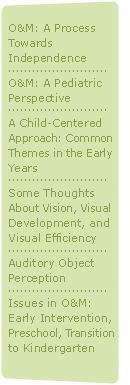|

|
Some
Thoughts about Vision, Visual Development, and Visual
Efficiency
by
Joe Cutter
If
the baby with normal vision does not have 20/20 vision
at birth, what does this say about the visual efficiency
of the visually impaired baby?
Consider
some of these factors: head control, color contrast,
lighting, object size, speed of object or person, viewing
distance, angle of viewing, field of vision, expectations
of significant others, and behavior state of baby/child.
At
two weeks, babies with normal vision recognize/show
preference for face-like patterns over random patterns.
What does this imply for the blind child?
Within
the first days of life, the newborn brings his/her hands
to mouth, face, ears, nose, eyes. This sequence is learned
by repeated attempts at mastery. This hand-head contact,
which is tactually directed, is a precursor to visual
reach. Therefore, reach "on body" before "off body"
connects visual reaching through touch to someone else.
With
multiply handicapped children, vision may integrate
through touch for a longer period of time before auditory
stimulus alone. In other words, elicit visual attention
through vestibular and proprioceptive systems. "Visual
stimulation"—"out there"—beyond the child,
is not enough.
The
child will prefer to use available vision in a way that
is natural for him or her. The child will also tend
to use touch and hearing for what he or she cannot see
(visually). By pushing vision to the point of inefficiency,
we interrupt the natural order for the child. Our role
is to present and teach the alternative techniques so
that the child develops skills of blindness as well
as visual skills. Simply stated: the child uses vision
for what he/she can see and the skills of blindness
for what he/she can't see.
|

